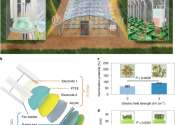NASA's IXPE sends first science image
In time for Valentine's Day, NASA's Imaging X-Ray Polarimetry Explorer which launched Dec. 9, 2021, has delivered its first imaging data since completing its month-long commissioning phase.

In time for Valentine's Day, NASA's Imaging X-Ray Polarimetry Explorer which launched Dec. 9, 2021, has delivered its first imaging data since completing its month-long commissioning phase.
Astronomy
Feb 16, 2022
0
73

A comprehensive investigation by KAUST researchers sets the record straight on the formation of hydrogen peroxide in micrometer-sized water droplets, or microdroplets, and shows that ozone is the key to this transformation1,2.
Materials Science
Feb 15, 2022
3
61

The recent launches of the James Webb Space Telescope (Webb) and the Imaging X-ray Polarimetry Explorer (IXPE) by NASA and its international partners are excellent reminders that the universe emits light or energy in many ...
Astronomy
Feb 2, 2022
1
61

Dark matter, a hypothetical material that does not absorb, emit or reflect light, is thought to account for over 80 percent of the matter in the universe. While many studies have indirectly hinted at its existence, so far, ...

Even though Earth's magnetic field shields us from solar wind and space weather, it doesn't always offer complete protection. Researchers have discovered a new mechanism in Earth's space environment that can allow solar particles ...
Earth Sciences
Feb 1, 2022
1
377

When a solid object hits a liquid, the impact produces shock waves: a process that has long occupied engineers due to its implications for design of hydraulic systems or motors. KAUST researchers now show that impacts at ...
General Physics
Jan 31, 2022
0
170

People around the world looked on in awe at the spectacular satellite images of an undersea volcano erupting in a giant mushroom cloud in the Pacific. Many wondered why the blast was so big, how the resulting tsunami traveled ...
Environment
Jan 19, 2022
0
13

A rare volcano-triggered tsunami sparked by the eruption of Hunga Tonga-Hunga Ha'apai in Tonga could have been caused by shock waves or shifting underwater land, experts said Monday.
Earth Sciences
Jan 17, 2022
0
87

A team of researchers affiliated with multiple institutions in China reports that electroculture can increase agricultural yields. In their paper published in the journal Nature Food, the group describes growing peas using ...

An international team of astronomers has conducted radio observations of a bow shock in the X-ray binary Vela X-1 using MeerKAT telescope. The observational campaign resulted in the detection of radio emission from this source. ...